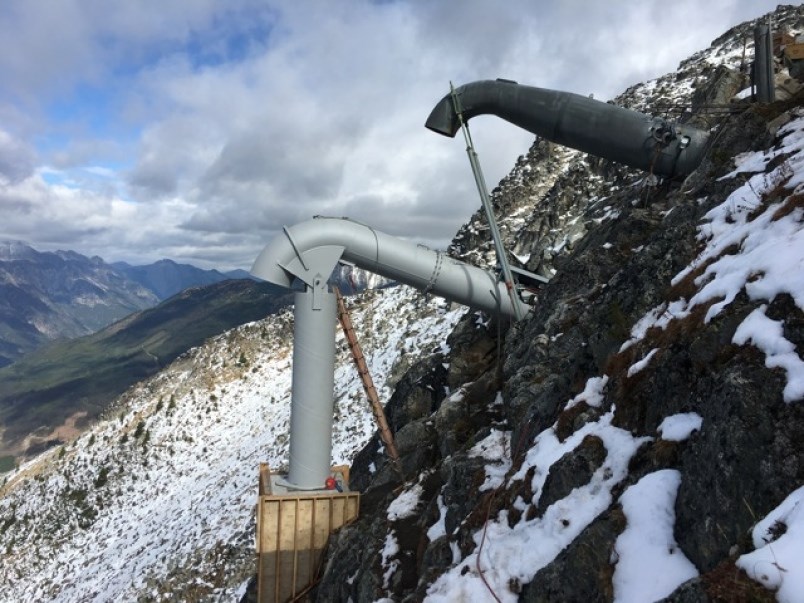Boom! Whoosh! Snow rushes down the mountainside.
It’s another day in the life of the avalanche technicians who work in the mountains above the Duffey Lake Road (Highway 99 South).
The highway north has been closed a number of times this winter for avalanche control because of concerns about the unstable and sometimes unpredictable snowpack on the snowy peaks above the road.
While local motorists are inconvenienced and delayed by avalanches on the Duffey Lake Road, it is not one of the primary avalanche areas in B.C.
“We have avalanche areas like the Duffey throughout B.C.,” said John Buffery, senior avalanche officer for BC Highways. “All told, there are 1,400 avalanche paths like avalanche Path 51 in the Duffey, which is problematic. That’s a fairly large avalanche path and the consequences of it do close the road. But if you look at areas in B.C. that have had multiple closures over the years, Three Valley Gap has eight closures a year. Up in Kootenay Pass, they have probably the same number, whereas this year, the Duffey Lake Road has closed once this year. Last year, there was one closure. ”
He said that, over the years, the Ministry of Transportation and Infrastructure’s Snow Avalanche Program has installed “fairly robust infrastructure that lives up in the start zone of that avalanche path.”
That “living” infrastructure is called the Gazex explosion control system, which consists of three large steel tubes connected to oxygen and propane pipelines. The remote-controlled system explodes the propane/oxygen inside the open metal tube, sending up to 20 kilograms of TNT and a shock wave into the snowpack.
Buffery explained, “We have professional technicians all over the province who monitor the snowpack for instability. At the right time, the technician for that area will pull up the radio repeaters connected to a computer and in a series of sequencing numbers, start up the gas flow into these massive cannons and once it reaches a certain level, an ignition will occur and it percusses a very large air blast in that start zone that collapses the weak layer of snow. It makes a huge, huge noise.”
How is the “right time” determined?
Factors such as fracture lines, unstable snowpacks, data from remote weather stations (snow weight, moisture levels, temperature), and recent avalanches in the area all come into play for the three technicians who monitor conditions in the Duffey Lake area.
Avalanche technicians have other options for triggering the massive falls of snow, ice and rock; they can employ helicopters to drop explosives on a vulnerable mountain.
“We’re always looking for the best solution,” continued Buffery. “Different areas have different solutions. In the Duffey Lake area, technicians have been looking at another device called the avalanche pipe. It’s for shorter slopes. The avalanche pipe has been tested and it’s still in review. We’re always on the lookout – trying to find a solution to the problem.”
Buffery has been an avalanche professional for 36 years.
He says anyone who wants to pursue a career in avalanche control “has to have a passion for the mountains and to have traveled in the mountains. I think you have to have a curiosity about the phenomenon that is an avalanche. And then you study it – there are structured courses through the Canadian Avalanche Association and you study, you do research, you practise and you get different accreditations using explosives. It takes a lifetime. All of us are dedicated; it’s not just a job, it’s a passion.”
“Phenomenal” changes in technology have occurred during Buffery’s 36 years in avalanche control.
“It used to almost be considered a black art,” he said with a laugh. “Or you would yodel and bring down the avalanche.” Another laugh.
What about yodeling? Is there any truth to those Swiss folk tales?
He’s given it some thought and offers this response:
“Now we use an exploder but the ideal of yodeling was similar; it was that you kind of echoed the air, but really what you’re doing is percussing the air and collapsing these layers of snow. The ideas are the same but the practicality is quite different, in terms of understanding the nuances of what’s needed to make things happen.”
More emphatically, he describes the idea that yodeling triggers an avalanche as an “old wives’ tale.”
However, Buffery does speculate that watchers and mountain guides in the Swiss Alps may have used their signature yodels to warn others in the path of an avalanche to get out of the way.
But that’s as far as his speculation goes.



